Manage Physical Assets (Finance)
37 Pages6268 Words409 Views
Added on 2023-06-06
About This Document
This article discusses the management of physical assets in finance, including asset registers, maintenance programs, and acquisition decisions. It also covers operational requirements, design features, and lease agreements.
Manage Physical Assets (Finance)
Added on 2023-06-06
ShareRelated Documents
Running head: MANAGE PHYSICAL ASSETS (FINANCE)
Manage Physical Assets (Finance)
Name of the Student:
Name of the University:
Authors Note:
Manage Physical Assets (Finance)
Name of the Student:
Name of the University:
Authors Note:
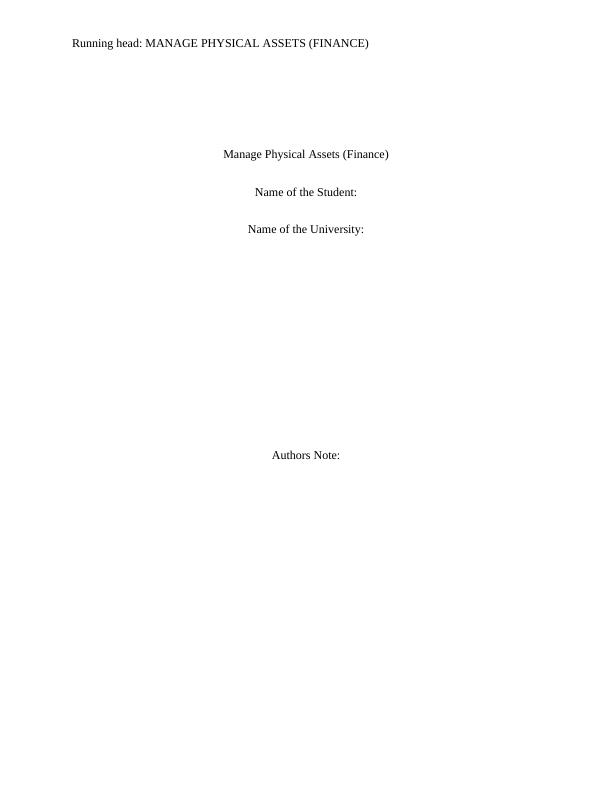
1
MANAGE PHYSICAL ASSETS (FINANCE)
Contents
Section 1:.........................................................................................................................................2
Section 2:.........................................................................................................................................7
Section 3:.........................................................................................................................................9
Assessment task 3:.........................................................................................................................20
Task 1:.......................................................................................................................................20
Task 2:.......................................................................................................................................29
Task 3:.......................................................................................................................................32
References:....................................................................................................................................35
MANAGE PHYSICAL ASSETS (FINANCE)
Contents
Section 1:.........................................................................................................................................2
Section 2:.........................................................................................................................................7
Section 3:.........................................................................................................................................9
Assessment task 3:.........................................................................................................................20
Task 1:.......................................................................................................................................20
Task 2:.......................................................................................................................................29
Task 3:.......................................................................................................................................32
References:....................................................................................................................................35
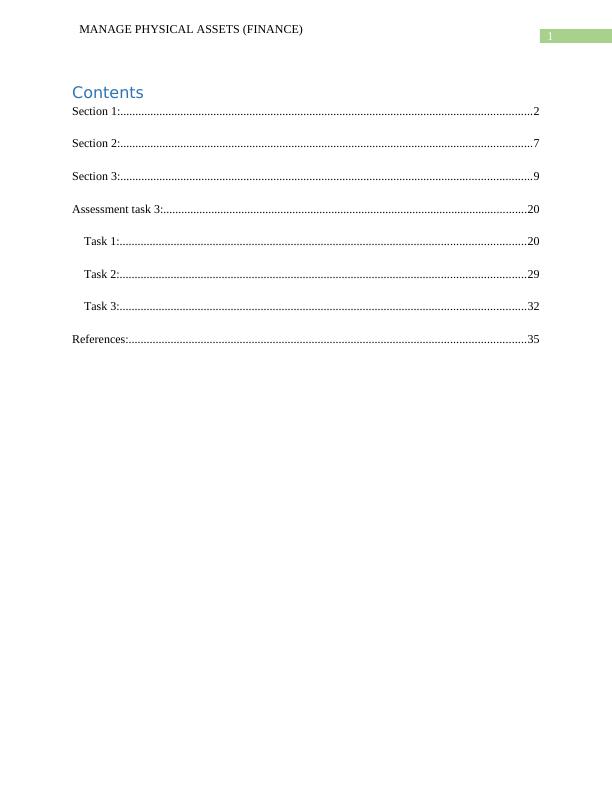
2
MANAGE PHYSICAL ASSETS (FINANCE)
Section 1:
Answer 1:
In a work organization as well as in a training institute generally the following physical assets
can be identified:
I. Land.
II. Building.
III. Plant and equipment.
IV. Machinery.
V. Motor vehicles.
VI. Furniture.
VII. Computers.
VIII. Printer.
IX. Air conditioner.
X. Water purifier (Haggerty et. al. 2017).
Answer 2:
Two primary reasons to maintain asset registers are:
I. Asset register helps an organisation to keep track of its assets and thus, maintenance
of assets becomes easier.
II. To keep record of assets such as asset type, date of acquisition etc. for future
reference (Gardiner, 2014).
Answer 3:
MANAGE PHYSICAL ASSETS (FINANCE)
Section 1:
Answer 1:
In a work organization as well as in a training institute generally the following physical assets
can be identified:
I. Land.
II. Building.
III. Plant and equipment.
IV. Machinery.
V. Motor vehicles.
VI. Furniture.
VII. Computers.
VIII. Printer.
IX. Air conditioner.
X. Water purifier (Haggerty et. al. 2017).
Answer 2:
Two primary reasons to maintain asset registers are:
I. Asset register helps an organisation to keep track of its assets and thus, maintenance
of assets becomes easier.
II. To keep record of assets such as asset type, date of acquisition etc. for future
reference (Gardiner, 2014).
Answer 3:
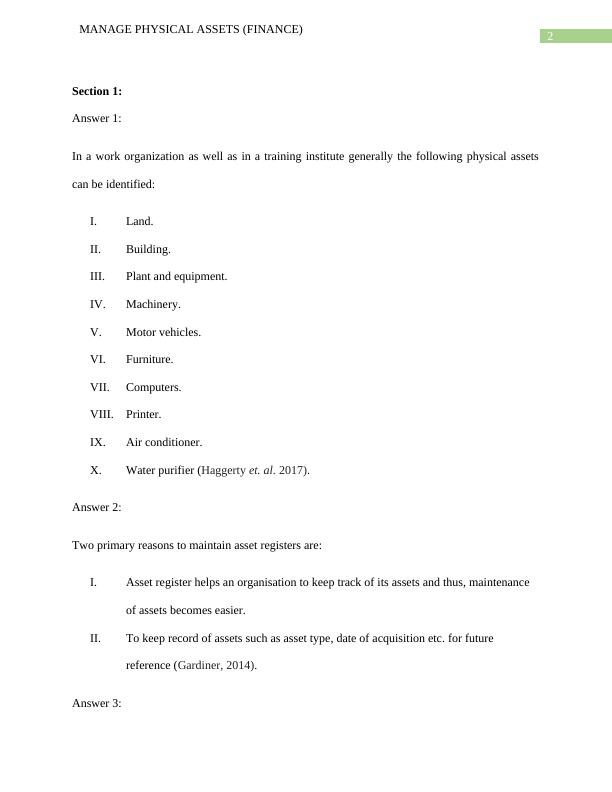
3
MANAGE PHYSICAL ASSETS (FINANCE)
Following are the eight details recorded in an asset register:
I. Asset name.
II. Asset type.
III. Asset specification.
IV. Date of acquisition of asset.
V. Identification code of the asset.
VI. Method of depreciation for the asset.
VII. Useful life of the asset.
VIII. Insurance details on the asset (Barney, 2017).
Answer 4:
In order to decide the method of depreciation applicable to each type of physical asset the most
important factor to be considered is the extent of use of such asset in the business. The useful life
of the asset is also another important consideration to be kept in mind while determining the
method of depreciation for a particular type of physical asset (Campbell, Jardine and McGlynn,
2016).
Answer 5:
The business objectives determines the extent of use of physical assets thus, the management of
such asset is very much dependant on business objectives. However, the general care and
protection of physical assets remain more or less similar irrespective of business objectives.
Answer 6:
MANAGE PHYSICAL ASSETS (FINANCE)
Following are the eight details recorded in an asset register:
I. Asset name.
II. Asset type.
III. Asset specification.
IV. Date of acquisition of asset.
V. Identification code of the asset.
VI. Method of depreciation for the asset.
VII. Useful life of the asset.
VIII. Insurance details on the asset (Barney, 2017).
Answer 4:
In order to decide the method of depreciation applicable to each type of physical asset the most
important factor to be considered is the extent of use of such asset in the business. The useful life
of the asset is also another important consideration to be kept in mind while determining the
method of depreciation for a particular type of physical asset (Campbell, Jardine and McGlynn,
2016).
Answer 5:
The business objectives determines the extent of use of physical assets thus, the management of
such asset is very much dependant on business objectives. However, the general care and
protection of physical assets remain more or less similar irrespective of business objectives.
Answer 6:
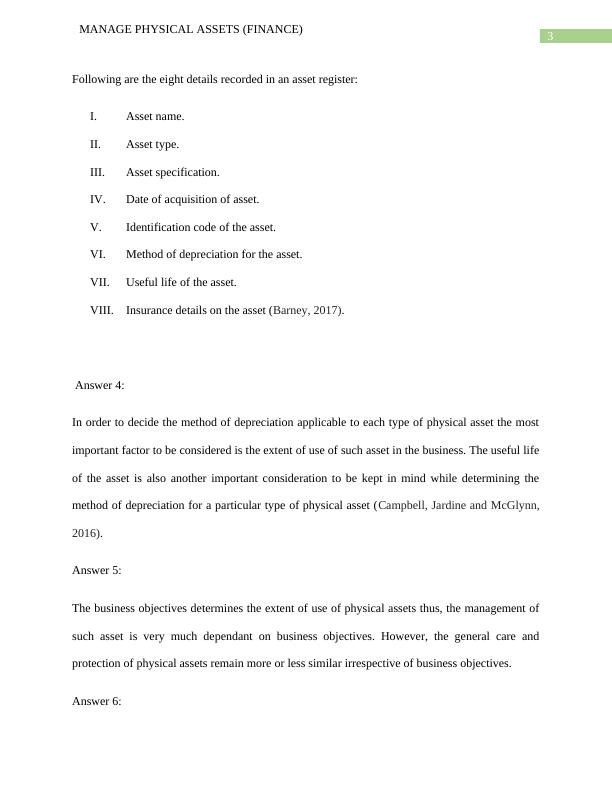
4
MANAGE PHYSICAL ASSETS (FINANCE)
Fix on fail:
This is the maintenance program where the physical assets are used extensively without much
maintenance. The physical assets are only repaired and fixed when the assets failed to perform
the required services (Kahn and Lemmon, 2016).
Comprehensive:
In comprehensive maintenance program an organization makes a comprehensive maintenance
plan for physical assets to enhance the life of these assets. Regular maintenance and repairing
work is conducted in physical asset under the program. Thus, the amount of expenditures is
relatively higher under the program. However, the expected lives of physical assets increased
significantly as a result of such maintenance program.
Preventive maintenance program:
In preventive program extensive amount of expenditures is incurred on maintenance of physical
assets with the objective of preventing the break-down of physical assets (Gârleanu and
Pedersen, 2015).
Answer 7:
The list to be followed to establish a maintenance program:
I. The type of physical asset and its specification.
II. The type of work for which the asset is to be used.
III. The number of hours that the asset will be in use each day.
IV. The replacement available for the asset in the organization in case of any break-down.
V. The importance of the asset for the day to day operations in an organization.
MANAGE PHYSICAL ASSETS (FINANCE)
Fix on fail:
This is the maintenance program where the physical assets are used extensively without much
maintenance. The physical assets are only repaired and fixed when the assets failed to perform
the required services (Kahn and Lemmon, 2016).
Comprehensive:
In comprehensive maintenance program an organization makes a comprehensive maintenance
plan for physical assets to enhance the life of these assets. Regular maintenance and repairing
work is conducted in physical asset under the program. Thus, the amount of expenditures is
relatively higher under the program. However, the expected lives of physical assets increased
significantly as a result of such maintenance program.
Preventive maintenance program:
In preventive program extensive amount of expenditures is incurred on maintenance of physical
assets with the objective of preventing the break-down of physical assets (Gârleanu and
Pedersen, 2015).
Answer 7:
The list to be followed to establish a maintenance program:
I. The type of physical asset and its specification.
II. The type of work for which the asset is to be used.
III. The number of hours that the asset will be in use each day.
IV. The replacement available for the asset in the organization in case of any break-down.
V. The importance of the asset for the day to day operations in an organization.
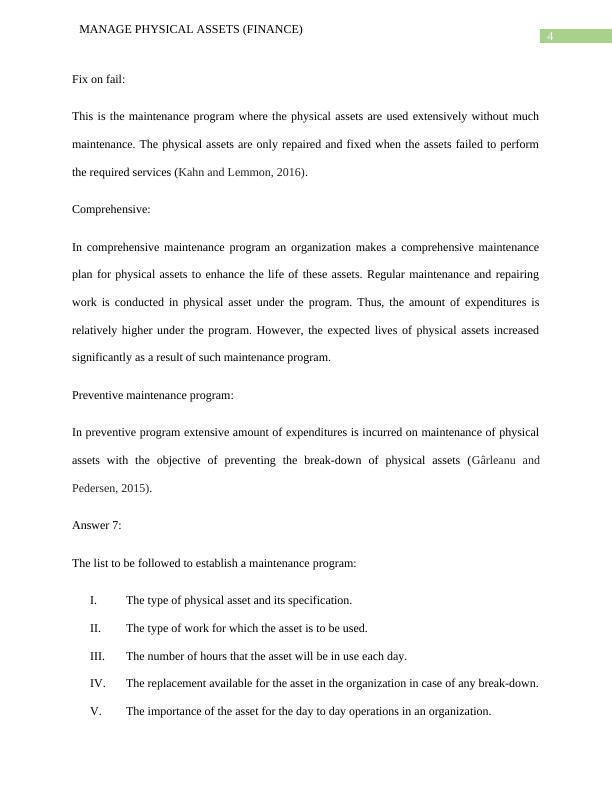
5
MANAGE PHYSICAL ASSETS (FINANCE)
VI. The cost of the asset and its useful life (Fung et. al. 2016).
Answer 8:
Asset Weekly Monthly Annual
Computers Cleaning and
checking the
computer and
attached cables.
Cleaning the hard
disk and if possible
taking back up.
Formatting after
taking back up.
Compulsory
maintenance and if
necessary installation
of new parts as
required.
Building Cleaning and
checking the fire
system within the
building.
Electric wiring
checking and
repairing.
Annual repairing,
painting and
renovation as
required.
Equipment Oiling and cleaning
the equipment.
Full check-up of the
equipment.
Annual reprinting
and maintenance as
per the maintenance
contract.
Answer 9:
The two factors to be considered while acquiring an asset as far as its environmental impact is
concerned are as following:
MANAGE PHYSICAL ASSETS (FINANCE)
VI. The cost of the asset and its useful life (Fung et. al. 2016).
Answer 8:
Asset Weekly Monthly Annual
Computers Cleaning and
checking the
computer and
attached cables.
Cleaning the hard
disk and if possible
taking back up.
Formatting after
taking back up.
Compulsory
maintenance and if
necessary installation
of new parts as
required.
Building Cleaning and
checking the fire
system within the
building.
Electric wiring
checking and
repairing.
Annual repairing,
painting and
renovation as
required.
Equipment Oiling and cleaning
the equipment.
Full check-up of the
equipment.
Annual reprinting
and maintenance as
per the maintenance
contract.
Answer 9:
The two factors to be considered while acquiring an asset as far as its environmental impact is
concerned are as following:

6
MANAGE PHYSICAL ASSETS (FINANCE)
I. Whether the use of the asset would contribute to the pollution in the environment.
II. The noise and heat to be generated due to the use of the asset in the working place.
Answer 10:
The business objectives have to be evaluated at the beginning. After the evaluation of the
objectives of the business a clear evaluation of the physical asset shall be conducted to determine
how the asset will contribute to the fulfilment of the business objectives. The financial
implications of acquiring the asset is to be determined by evaluating the proposal of acquiring
the asset. Investment appraisal techniques such as Net present value analysis would help the
business to determine whether the asset would be beneficial for the business or not (Campbell,
Jardine and McGlynn, 2016).
Answer 11:
The financial statements of a business shows the financial performance and position of the
business as on a particular period. The ability of a business to acquire an asset at present or in the
future can be very much evaluated from the financial position of the business. The amount of
retained earnings and the liquidity position of a business will very much reflect its ability to
acquire an asset or assets as on a particular date. Also the solvency position of an organization
helps such organization to take loan from banks to acquire assets for business. Thus, both current
as well as future ability of a business to acquire a particular can be evaluated from the
assessment of its financial position. In addition the ability of an organization to make optimum
use of its assets in the future is another factor that will contribute to the decision of an
organization to acquire an asset (Ma, Zhou and Sheng, 2014).
MANAGE PHYSICAL ASSETS (FINANCE)
I. Whether the use of the asset would contribute to the pollution in the environment.
II. The noise and heat to be generated due to the use of the asset in the working place.
Answer 10:
The business objectives have to be evaluated at the beginning. After the evaluation of the
objectives of the business a clear evaluation of the physical asset shall be conducted to determine
how the asset will contribute to the fulfilment of the business objectives. The financial
implications of acquiring the asset is to be determined by evaluating the proposal of acquiring
the asset. Investment appraisal techniques such as Net present value analysis would help the
business to determine whether the asset would be beneficial for the business or not (Campbell,
Jardine and McGlynn, 2016).
Answer 11:
The financial statements of a business shows the financial performance and position of the
business as on a particular period. The ability of a business to acquire an asset at present or in the
future can be very much evaluated from the financial position of the business. The amount of
retained earnings and the liquidity position of a business will very much reflect its ability to
acquire an asset or assets as on a particular date. Also the solvency position of an organization
helps such organization to take loan from banks to acquire assets for business. Thus, both current
as well as future ability of a business to acquire a particular can be evaluated from the
assessment of its financial position. In addition the ability of an organization to make optimum
use of its assets in the future is another factor that will contribute to the decision of an
organization to acquire an asset (Ma, Zhou and Sheng, 2014).

7
MANAGE PHYSICAL ASSETS (FINANCE)
Section 2:
Answer 12:
Impact:
In order to assess the impact of a physical asset on the performance of an organization the
following shall be evaluated:
I. The quantum of production.
II. The quality of production.
III. Production costs (Shah, McMann and Borthwick, 2017).
Effectiveness:
In order to assess the effectiveness of a physical asset on the performance of an organization the
following shall be evaluated:
I. How the production processes have changed.
II. The improvement in the goods and services.
III. Use of other resources in production of goods and proving services.
Long-term performance:
In order to assess the impact of physical asset on the long-term performance of an organization
the following shall be evaluated:
I. The profit from business operations.
II. The quality of goods and services whether improved or not.
MANAGE PHYSICAL ASSETS (FINANCE)
Section 2:
Answer 12:
Impact:
In order to assess the impact of a physical asset on the performance of an organization the
following shall be evaluated:
I. The quantum of production.
II. The quality of production.
III. Production costs (Shah, McMann and Borthwick, 2017).
Effectiveness:
In order to assess the effectiveness of a physical asset on the performance of an organization the
following shall be evaluated:
I. How the production processes have changed.
II. The improvement in the goods and services.
III. Use of other resources in production of goods and proving services.
Long-term performance:
In order to assess the impact of physical asset on the long-term performance of an organization
the following shall be evaluated:
I. The profit from business operations.
II. The quality of goods and services whether improved or not.
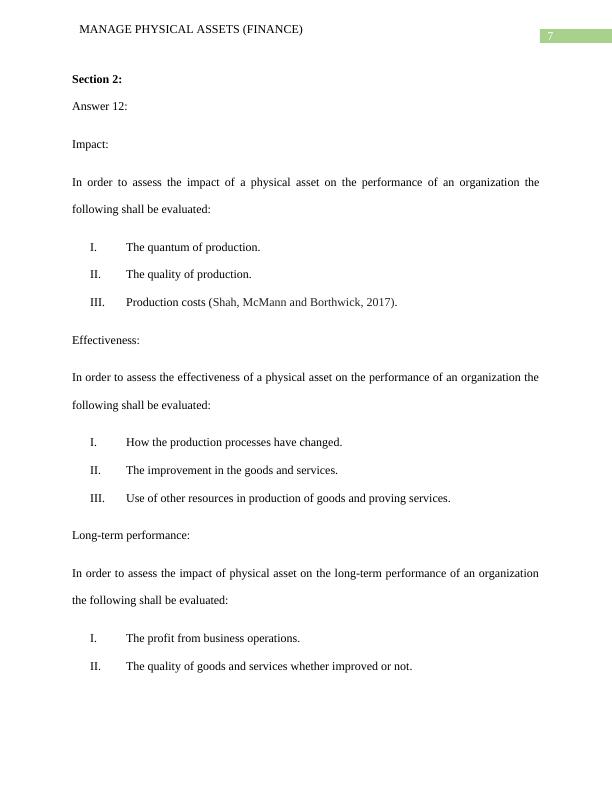
End of preview
Want to access all the pages? Upload your documents or become a member.
Related Documents
LAW 79017 - The Taxation Law : Assignmentlg...
|13
|3000
|71
TAXATION LAW TAXATION LAW 11 Taxation Law Name of the student Name of the universitylg...
|13
|2133
|338
ADVANCED FINANCIAL ACCOUNTING 1 Advanced FINANCIAL ACCOUNTING Author Note Assessment Task Part Alg...
|10
|2701
|121
Taxation Ruling | Questions and Answerslg...
|16
|2648
|238
Answer to Question No 2 10 Reference List 13 Answeef Taxation Law of Australialg...
|15
|3184
|298
Strengths of internal control of the acquisitionlg...
|9
|2034
|173
